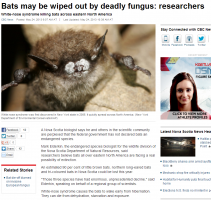 Bats may not be welcome in people’s houses; but that doesn’t mean they don’t deserve mankind’s kindness. As of this writing, efforts by the government of Canada are underway to save several species of bats across the eastern part of North America from extinction. CBC News reports that according to biologists, bats on this side of the continent are in danger from a type of killer disease known as the white nose syndrome. This illness has been driving bats to take refuge in suburbs.
Bats may not be welcome in people’s houses; but that doesn’t mean they don’t deserve mankind’s kindness. As of this writing, efforts by the government of Canada are underway to save several species of bats across the eastern part of North America from extinction. CBC News reports that according to biologists, bats on this side of the continent are in danger from a type of killer disease known as the white nose syndrome. This illness has been driving bats to take refuge in suburbs.
Several provinces in Canada—Ontario, Quebec, Nova Scotia, Prince Edward Island, and Newfoundland and Labrador—have confirmed white nose syndrome laying waste to bat populations. According to the USGS National Wildlife Health Center, this disease hits a bat’s sensory organs, namely its muzzle and ears. Since the fungus, Geomyces destructans, thrives in low temperatures, bats often move to warmer places such as insulated attics. This, of course, elicits the necessary animal control response by the homeowners or residents.
It’s interesting to note that the fungus itself doesn’t actually do the killing; it induces the secondary effects that drive a bat to its demise. Scientists say that the fungus increases bat activity, even when it’s supposed to be in hibernation. As a result, a bat infected with the fungus expends the body fat reserves meant to tide the animal over while being inactive during the cold season, leading to its death from exposure, dehydration, and even starvation. In their disoriented state, these afflicted bats exhibit abnormal activity such as daytime flights.
As much as you want to save bats from the dreaded disease, letting them stay in your attic may prove harmful. Their droppings may damage the insulation and the interior roofing structure, making the bat (and you) more exposed to the elements. Furthermore, their fetid droppings may attract pests, and produce a stench that may fill the entire house. Breaches in the roofing may serve as access points for these animals.
Both the U.S. and Canada have initiated measures to help protect what’s left of the bat population in eastern North America. Over a month ago, Environment Canada announced funding for a national response plan that includes information dissemination and disease surveillance. In the U.S., alternative locations such as Cold War-era bunkers are carefully being considered as bat refuges. There’s even a call for Canada to declare the bats endangered.
Many hope that it’s not too late to save the dwindling bat population while keeping them out of your roof. In line with humane wildlife control practices, Mississauga animal control specialists such as Skedaddle will be involved in the collective rescue effort. Apart from ethical considerations on biodiversity, preserving bats is essential due to the valuable roles they play in insect control and pollination. Bats may soon have a sanctuary away from the fast-moving disease that has already claimed millions.


